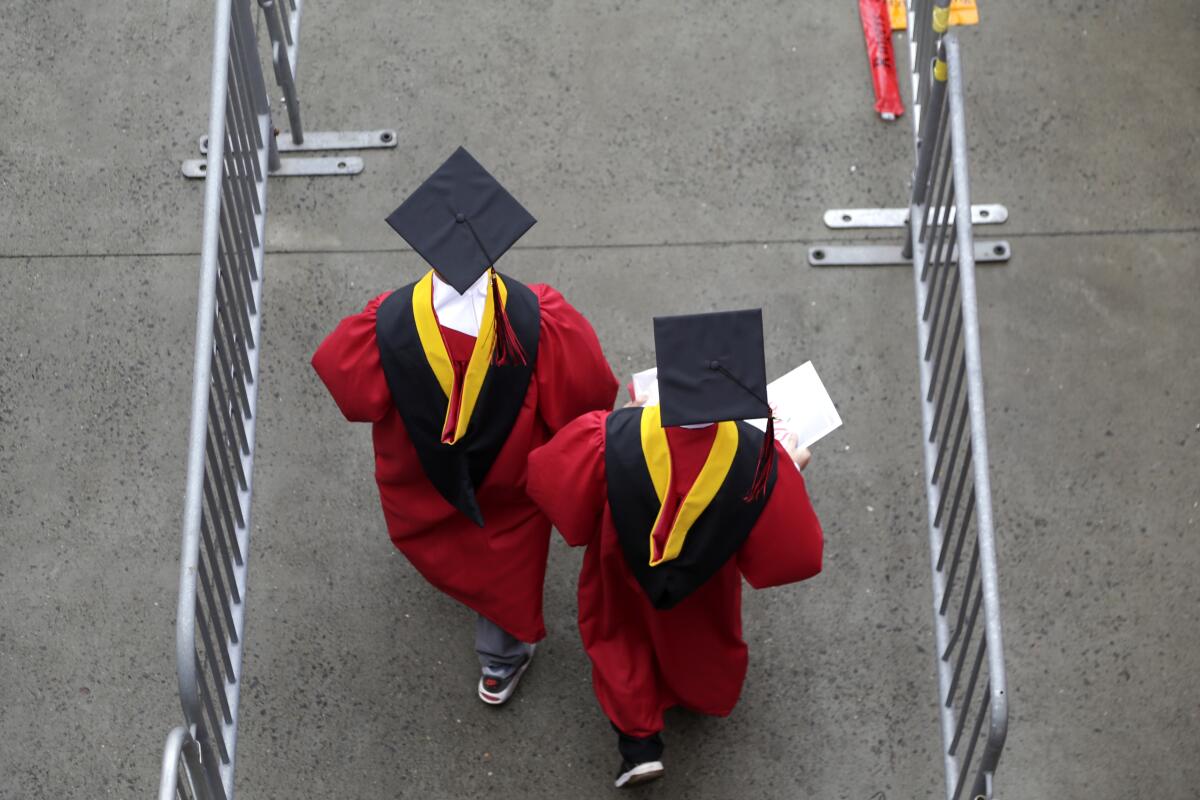Op-Ed: Biden’s debt cancellation will help millions, but it won’t end the student loan crisis

- Share via
In a remarkable move, the Biden administration on Wednesday announced that it would cancel millions of dollars in federal student loans, giving struggling student borrowers some concrete good news. This mini debt jubilee, accompanied by another extension of repayment obligations and a new income-driven repayment plan, is a critical step in addressing the slow-boil crisis of student debt.
The administration’s new policy will erase up to $10,000 of federal student debt for individual borrowers earning less than $125,000 per year (or $250,000 per household) and up to an additional $10,000 for borrowers who received Pell grants as undergraduates. And the payment pause, initiated under the previous administration, now will expire at the end of the year.
The White House estimates that this policy will completely wipe out the debt of 20 million borrowers. These low-balance borrowers are more likely to have a delinquency or default, so this new policy will greatly help those most likely to struggle when payment obligations resume on Jan. 1. An analysis from the Student Loan Law Initiative estimates that as many as 41 million out of the 45 million student loan borrowers will receive some form of cancellation; the remaining 4 million do not qualify based on income.
An estimated 100 million Americans have medical debt, and 18% say they will never be able to pay off what they owe.
Cancellation will also help to narrow the wealth gap between Black and white borrowers, because Black borrowers are more likely to have to borrow. The SLLI analysis also estimates that this new policy will wipe out the debts of 3.8 million Black borrowers, almost half of all Black people with federal student loan debt.
Important details remain murky. The administration also announced that it will be able to process cancellation automatically for approximately 8 million borrowers for whom it has recent income data. Unfortunately, the remaining 33 million eligible borrowers will have to go through a to-be-revealed application process to prove their income eligibility. This all but ensures that when student loan payments resume in January, some borrowers will begin repaying on the wrong balance.
There is much to celebrate, and then there is the big picture, which remains grim. This mass cancellation — politically unimaginable just five years ago — is not the end of the student loan crisis. Congressional action is still needed to reform the way the government funds higher education. Cancellation of payment obligations for those who have balances today does little for those who started borrowing to begin school now or will in the future. As one first-year law student asked, “What about us?”
The cost of higher education remains a hurdle for millions. College costs money and someone has to pay. But if federal loans — meant to make college possible — deter prospective students from going to college, then they are the wrong tools for the job.
States can and the federal government should create new programs and strategies to reduce the share of the cost borne by students. New Mexico, for example, is establishing a new free tuition policy. Left unaddressed, the rising cost of college and the need to borrow will continue to perpetuate inequality, contribute to the racial wealth gap and undermine the promise of education.
Current programs to assist borrowers in repayment remain complex and difficult to use. Conspicuously absent from the announcement of debt cancellation was mention of the impending expiration of the waiver that has made it easier for borrowers to take advantage of the Public Service Loan Forgiveness program; that waiver expires at the end of October.
Reducing the loan burden would help millions of students, but particularly Black and Latino graduates, who tend to receive lower wages, another manifestation of structural racism.
Some have criticized student loan cancellation as unfair because it reaches only those with current balances, not those who have already repaid. But this makes no sense. It’s akin to complaining that one could have benefited from a government program that did not previously exist.
The administration’s plan may draw a legal challenge, contesting the president’s authority to cancel debts en masse. There may be legal arguments to be made — we think they are thin — but the suspension of payment obligations that has been in place since the onset of the COVID-19 pandemic relied on the same legal authority, so a successful challenge could have dire consequences for borrowers who have enjoyed a respite from monthly payments and accruing interest.
The pandemic has only increased the challenges student debt poses, and cancellation is a momentous step to reduce the immediate pain felt by millions of Americans. Yet at the same time the move constitutes tacit acknowledgment of the need for broader and permanent reform of higher education finance. Much remains to be done.
Jonathan D. Glater is a professor at UC Berkeley School of Law. Dalié Jiménez is a professor at UC Irvine School of Law. They are co-founders of the Student Loan Law Initiative.
More to Read
A cure for the common opinion
Get thought-provoking perspectives with our weekly newsletter.
You may occasionally receive promotional content from the Los Angeles Times.












